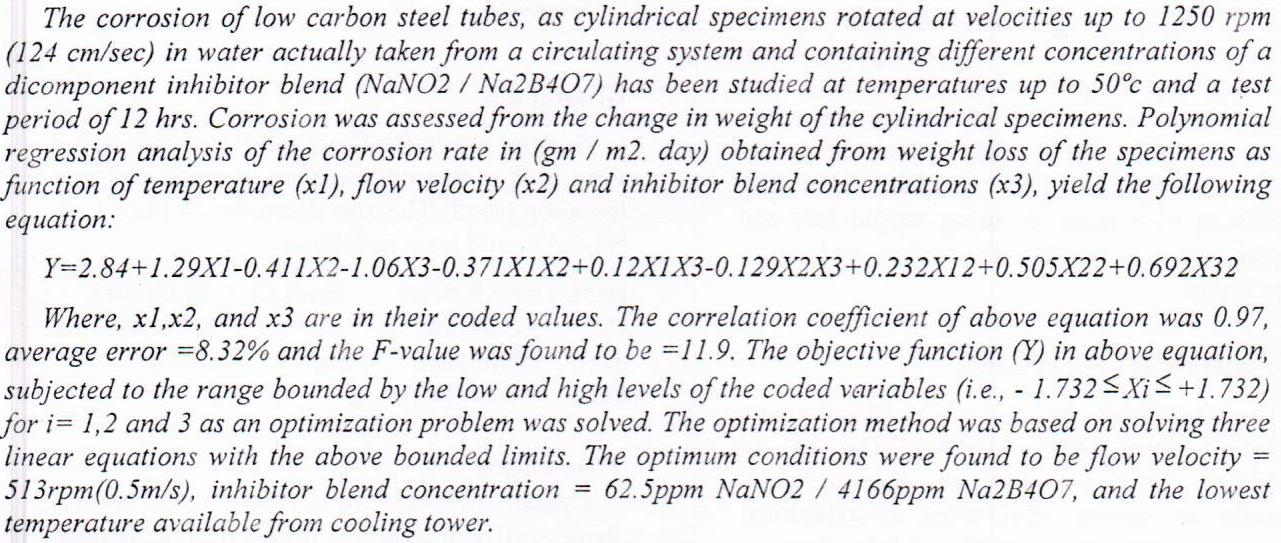
A theoretical study on corrosion inhibitors was done by quantum calculations includes semi-empirical PM3 and Density Functional Theory (DFT) methods based on B3LYP/6311++G (2d,2P). Benzimidazole derivative (oxo(4- ((phenylcarbamothioyl) carbamoyl)phenyl) ammonio) oxonium (4NBP) and thiourea derivative 2-((4- bromobenzyl)thio) -1H-benzo[d] imidazole (2SB) were used as corrosion inhibitors and an essential quantum chemical parameters correlated with inhibition efficiency, EHOMO (highest occupied molecular orbital energy) and ELUMO (lowest molecular orbital energy). Other parameters are also studied like energy gap [ΔE (HOMO-LUMO)], electron affinity (EA), hardness (Δ), dipole moment (μ), softness (S), ionization potential (IE), absolut
... Show More (66)
(66)
 (57)
(57)
The inhibitive action of Phenyl Thiourea (PTU) on the corrosion of mild steel in strong Hydrochloric acid, HCl, has been investigated by weight loss and potentiostatic polarization. The effect of PTU concentration, HCl concentration, and temperature on corrosion rate of mild steel were verified using 2 levels factorial design and surface response analysis through weight loss approach, while the electrochemical measurements were used to study the behavior of mild steel in 5-7N HCl at temperatures 30, 40 and 50 °C, in absence and presence of PTU. It was verified that all variables and their interaction were statistically significant. The adsorption of (PTU) is found to obey the Langmuir adsorption isotherm. The effect of temperature on th
... Show MoreIn this study, polymeric coating was developed by incorporating nano graphene in the polymer blend with applications to oil storage tanks. The oil storage tanks samples were brought from the oil Pipeline Company / Doura refinery in Baghdad. The coating polymer was formed with a blend (epoxy resin and repcoat ZR). The proportion of mixing the mixture was 3:1:1 epoxy resin 21.06 gm: repcoat ZR 10.53 gm: hardener 10.53 gm. The blend/graphene was prepared using in stui-polymerization method with different weight percentage 1, 3, 5, and 7 wt % added to blend. The resulting solution was put in a glass tube on a magnetic stirrer for one hour at a temperature of 40 °C. The result of contact angle and wate
... Show More (1)
(1)
 (13)
(13)
 (9)
(9)
The corrosion behavior of copper and carbon steel in 1M concentration of hydrochloric acid (HCl) and sulphuric acid (H2SO4) has been studied. The corrosion inhibition of copper and carbon steel in 1M concentration of hydrochloric acid (HCl) and sulphuric acid (H2SO4) by Ciprofloxacin has been investigated. Specimens were exposed in the acidic media for 7 hours and corrosion rates evaluated by using the weight loss method. The effect of temperature (from 283 ºK to 333 ºK), pH (from 1to 6), inhibitor concentration (10-4 to 10-2) has been studied. It was observed that sulphuric acid environment was most corrosive to the metals because of its oxidizing nature, followed by hydrochloric acid. The rate of metal dissolution increased with incre
... Show More (2)
(2)
In this research, non-thermal plasma system of argon gas is designed to work at normal atmospheric pressure and suitable for work in medical and biotechnological applications. This technique is applied in the treatment of the Staphylococcus epidermidis bacteria and show the role of the flow rate of Argon gas on the killing rate of bacteria, and it obtained a 100 % killing rate during the time of 5 minutes at the flow Argon gas of 5 liters/ min.
 (1)
(1)
This paper investigates the effect of magnetohydrodynamic (MHD) of an incompressible generalized burgers’ fluid including a gradient constant pressure and an exponentially accelerate plate where no slip hypothesis between the burgers’ fluid and an exponential plate is no longer valid. The constitutive relationship can establish of the fluid model process by fractional calculus, by using Laplace and Finite Fourier sine transforms. We obtain a solution for shear stress and velocity distribution. Furthermore, 3D figures are drawn to exhibit the effect of magneto hydrodynamic and different parameters for the velocity distribution.
 (3)
(3)
 (1)
(1)
Duration of each developmental stage of the house dust mite Dermatophagoides pteronyssinus together with the mortality percentage were observed at a combination of five different temperatures namely 20C°, 22.5C°, 25C°, 27.5C° and 30C° and four different humidities namely 55%, 75%, 85% and 95% r. h. Results showed that temperature had the greatest effect on the life cycle period. The higher the temperature the shorter the life cycle was aid versa verea. On the other hand, humidity seems to be less effectiveness, though at the higher temperature and humidity no development was occured. Mortality among all temperatures and humidities appeared nearly the same, but at higher temperature and higher humidity and because of mould g
... Show MoreThis study aims to find the effect of water-cement ratio on the compressive strength of concrete by using ultrasonic pulse velocity test (UPVT). Over 230 standard cube specimens were used in this study, with dimensions of 150mm, and concrete cubes were cured in water at 20 °C. Also, the specimens used in the study were made of concrete with varied water-cement ratio contents from 0.48 to 0.59. The specimens were taken from Diyarbakir-Turkey concrete centers and tested at the structure and material science lab, civil engineering, faculty of engineering from Dicle University. The UPV measurement and compressive strength tests were carried out at the concrete age of 28 days. Their UPV and compressive strength ranged
... Show More (1)
(1)
